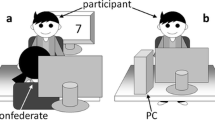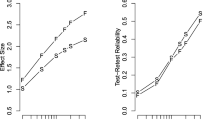Abstract
The following paper describes Lowenkron’s model of joint (stimulus) control. Joint control is described as a means of accounting for performances, especially generalized performances, for which a history of contingency control does not provide an adequate account. Examples are provided to illustrate instances in which joint control may facilitate performance of a task.
Similar content being viewed by others
References
Lowenkron, B. (1984). Coding responses and the generalization of matching-to-sample in children. Journal of the Experimental Analysis of Behavior, 42, 1–18.
Lowenkron, B. (1988). Generalization of delayed identity matching in retarded children. Journal of the Experimental Analysis of Behavior, 50, 163–172.
Lowenkron, B. (1989). Instructional control of generalized relational matching to sample in children. Journal of the Experimental Analysis of Behavior, 52, 293–309.
Lowenkron, B. (1991). Joint control and the generalization of selection-based verbal behavior. The Analysis of Verbal Behavior, 9, 121–126.
Lowenkron, B. (1998). Some logical functions of joint control. Journal of the Experimental Analysis of Behavior, 69, 327–354.
Lowenkron, B. (2004). Meaning: A verbal behavior account. The Analysis of Verbal Behavior, 22, 121–126.
Lowenkron, B. (2006). Joint control and the selection of stimuli from their description. The Analysis of Verbal Behavior, 22, 129–150.
Lowenkron, B., & Colvin, V. (1992). Joint control and generalized nonidentity matching: Saying when something is not. The Analysis of Verbal Behavior, 10, 1–10.
Lowenkron, B., & Colvin, V. (1995). Generalized instructional control and the production of broadly applicable relational responding. The Analysis of Verbal Behavior, 12, 13–29.
Skinner, B. F. (1957). Verbal behavior. New York: Prentice Hall.
Author information
Authors and Affiliations
Corresponding author
Additional information
Word-object bi-directional symmetry refers to the observation that children may be trained to either tact objects or to find objects given their name and once one of these relations is taught, the other may emerge without training. Elaborate
”For Dummies” is trademark Wiley and Sons publishers. Permission being sought to use this title.
This paper is based on a presentation given at the 29th annual convention of the Behavior Analysis Association of Michigan. Thanks to Barry Lowenkron for helpful comments on an earlier draft of this manuscript.
Rights and permissions
About this article
Cite this article
Sidener, D.W. Joint Control for Dummies: An Elaboration of Lowenkron’s Model of Joint (Stimulus) Control. Analysis Verbal Behav 22, 119–122 (2006). https://doi.org/10.1007/BF03393033
Published:
Issue Date:
DOI: https://doi.org/10.1007/BF03393033




